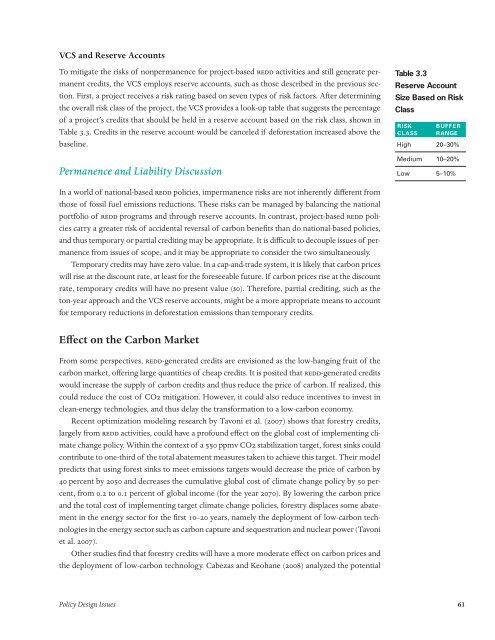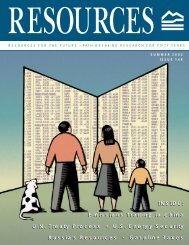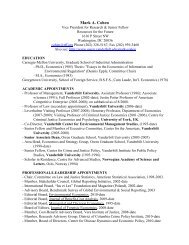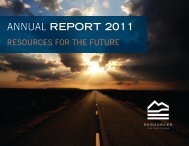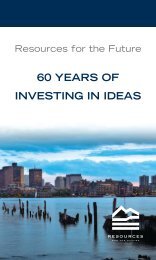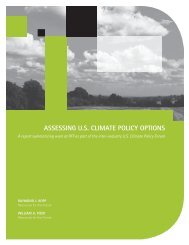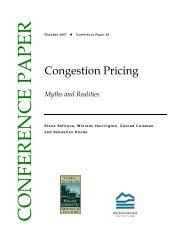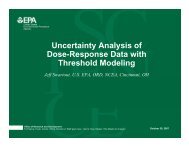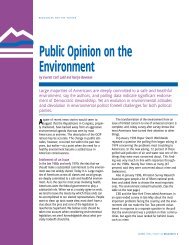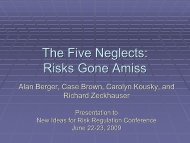Policies to Reduce Emissions from Deforestation and Degradation ...
Policies to Reduce Emissions from Deforestation and Degradation ...
Policies to Reduce Emissions from Deforestation and Degradation ...
You also want an ePaper? Increase the reach of your titles
YUMPU automatically turns print PDFs into web optimized ePapers that Google loves.
VCS <strong>and</strong> Reserve Accounts<br />
To mitigate the risks of nonpermanence for project-based REDD activities <strong>and</strong> still generate permanent<br />
credits, the VCS employs reserve accounts, such as those described in the previous section.<br />
First, a project receives a risk rating based on seven types of risk fac<strong>to</strong>rs. After determining<br />
the overall risk class of the project, the VCS provides a look-up table that suggests the percentage<br />
of a project’s credits that should be held in a reserve account based on the risk class, shown in<br />
Table 3.3. Credits in the reserve account would be canceled if deforestation increased above the<br />
baseline.<br />
Permanence <strong>and</strong> Liability Discussion<br />
In a world of national-based REDD policies, impermanence risks are not inherently different <strong>from</strong><br />
those of fossil fuel emissions reductions. These risks can be managed by balancing the national<br />
portfolio of REDD programs <strong>and</strong> through reserve accounts. In contrast, project-based REDD policies<br />
carry a greater risk of accidental reversal of carbon benefits than do national-based policies,<br />
<strong>and</strong> thus temporary or partial crediting may be appropriate. It is difficult <strong>to</strong> decouple issues of permanence<br />
<strong>from</strong> issues of scope, <strong>and</strong> it may be appropriate <strong>to</strong> consider the two simultaneously.<br />
Temporary credits may have zero value. In a cap-<strong>and</strong>-trade system, it is likely that carbon prices<br />
will rise at the discount rate, at least for the foreseeable future. If carbon prices rise at the discount<br />
rate, temporary credits will have no present value ($0). Therefore, partial crediting, such as the<br />
<strong>to</strong>n-year approach <strong>and</strong> the VCS reserve accounts, might be a more appropriate means <strong>to</strong> account<br />
for temporary reductions in deforestation emissions than temporary credits.<br />
Effect on the Carbon Market<br />
From some perspectives, REDD-generated credits are envisioned as the low-hanging fruit of the<br />
carbon market, offering large quantities of cheap credits. It is posited that REDD-generated credits<br />
would increase the supply of carbon credits <strong>and</strong> thus reduce the price of carbon. If realized, this<br />
could reduce the cost of CO2 mitigation. However, it could also reduce incentives <strong>to</strong> invest in<br />
clean-energy technologies, <strong>and</strong> thus delay the transformation <strong>to</strong> a low-carbon economy.<br />
Recent optimization modeling research by Tavoni et al. (2007) shows that forestry credits,<br />
largely <strong>from</strong> REDD activities, could have a profound effect on the global cost of implementing climate<br />
change policy. Within the context of a 550 ppmv CO2 stabilization target, forest sinks could<br />
contribute <strong>to</strong> one-third of the <strong>to</strong>tal abatement measures taken <strong>to</strong> achieve this target. Their model<br />
predicts that using forest sinks <strong>to</strong> meet emissions targets would decrease the price of carbon by<br />
40 percent by 2050 <strong>and</strong> decreases the cumulative global cost of climate change policy by 50 percent,<br />
<strong>from</strong> 0.2 <strong>to</strong> 0.1 percent of global income (for the year 2070). By lowering the carbon price<br />
<strong>and</strong> the <strong>to</strong>tal cost of implementing target climate change policies, forestry displaces some abatement<br />
in the energy sec<strong>to</strong>r for the first 10–20 years, namely the deployment of low-carbon technologies<br />
in the energy sec<strong>to</strong>r such as carbon capture <strong>and</strong> sequestration <strong>and</strong> nuclear power (Tavoni<br />
et al. 2007).<br />
Other studies find that forestry credits will have a more moderate effect on carbon prices <strong>and</strong><br />
the deployment of low-carbon technology. Cabezas <strong>and</strong> Keohane (2008) analyzed the potential<br />
Table 3.3<br />
Reserve Account<br />
Size Based on Risk<br />
Class<br />
RISK BUFFER<br />
CLASS RANGE<br />
High 20–30%<br />
Medium 10–20%<br />
Low 5–10%<br />
Policy Design Issues 1


